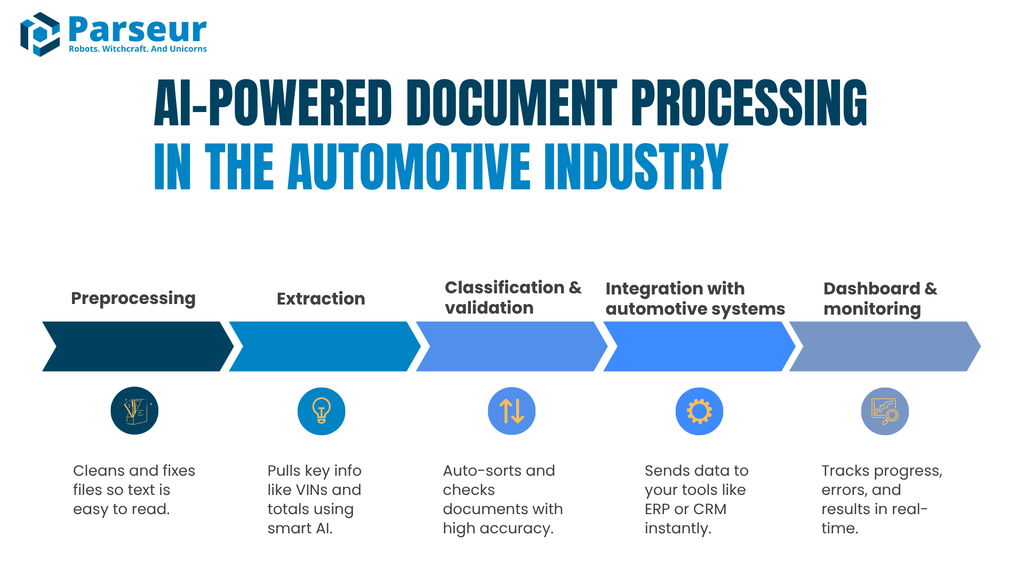Key Takeaways
- AI document processing reduces manual workload and speeds up operations.
- Parseur delivers up to 99.9% accuracy in extracting data from automotive documents.
- Automating forms like invoices and repair orders improves compliance and efficiency.
- Generative AI is driving the next wave of automation in the automotive industry.
In the automotive industry, paperwork piles up fast—from supplier invoices and repair orders to warranty forms and vehicle registrations. Handling all of this manually can slow teams down, lead to costly mistakes, and create frustrating delays. It’s a common challenge for dealerships, logistics companies, manufacturers, and repair centers alike.
For instance, car dealerships listing vehicles on platforms like Cars.com often receive sales leads via email, containing essential information such as customer details and vehicle preferences. Manually extracting and processing these leads not only delays response times but can also result in lost sales opportunities due to inaccuracies.
That’s where AI-powered document processing becomes a game-changer.
According to Allied Market Research, the global automotive artificial intelligence market is projected to reach over $405.3 billion by 2032, driven by automation, efficiency, and the need for scalable workflows.
Whether you're a dealership managing purchase orders or a logistics partner processing repair records, this technology enables smarter workflows and more accurate insights.
Why it matters to automotive companies
Automotive teams face increasing pressure to operate lean while staying compliant, customer-focused, and data-driven. Yet legacy systems and siloed operations often hold them back. Manual processes mean longer turnaround times, more human error, and limited scalability.
By implementing AI-powered document processing, automotive businesses can:
- Accelerate data workflows and reduce delays
- Eliminate repetitive manual entry across departments
- Improve data quality and customer service responsiveness
- Gain operational agility without overhauling existing systems
With Parseur, automotive teams can start automating document workflows in just a few clicks. Its email-to-JSON engine requires no technical knowledge and allows you to extract data from documents like quotes, purchase orders, invoices, and more without technical complexity. Whether you're sending files via email, uploading them manually, or using integrations with apps like Zapier, Parseur ensures your document data lands exactly where it needs to go.
What Is AI-Powered Document Processing?
Document processing has come a long way from scanners and spreadsheets. While traditional systems relied on basic Optical Character Recognition (OCR) to read and digitize documents, modern solutions now combine multiple AI technologies to extract and structure data more intelligently.
AI-powered document processing, often referred to as Intelligent Document Processing (IDP), goes beyond simply recognizing characters. It includes tools like Natural Language Processing (NLP), machine learning (ML), and computer vision to understand, classify, and extract meaningful data from a wide variety of document formats, whether scanned invoices, repair orders, or handwritten forms.
Why does document processing matter?
BayInfotech reported that a mid-sized federal agency handling over a million documents annually sees employees spending up to 30% of their time on manual admin tasks like data entry and verification. That adds up to thousands of hours lost to repetitive work. Manual entry also introduces a 1% average error rate, which means 10 errors for every 1,000 records, a risk that can lead to compliance issues and delayed operations in sectors like automotive.
Relying on manual processes creates unnecessary bottlenecks for automotive companies that must manage high volumes of purchase orders, VIN reports, invoices, and other documents. AI-powered document processing eliminates that risk by delivering faster, more accurate results while giving teams back their time.
What makes AI-powered document processing different?
Let’s break it down by core components:
OCR (Optical Character Recognition)
Detects printed or handwritten text in scanned documents.
ICR (Intelligent Character Recognition)
Builds on OCR by recognizing more complex handwriting and formatting styles.
NLP (Natural Language Processing)
Understands context, classifies content, and extracts specific data fields, such as vehicle makes, model numbers, or invoice totals.
Machine Learning & Deep Learning
Continuously improves parsing accuracy over time by learning from data patterns and user feedback.
RAG (Retrieval-Augmented Generation)
Enables AI to pull context and meaning from large datasets and unstructured documents, enhancing understanding for long-form documents.
By combining these technologies, tools like Parseur can extract meaningful data with precision and deliver it instantly to the systems automotive teams already use.
Why Automotive Companies Need AI Document Processing?
The automotive industry runs on documents, from vehicle titles and repair orders to supplier invoices, warranty claims, and compliance forms. When these are managed manually, they create operational drag, increase the risk of error, and slow down the entire workflow.
As reported by the SDC Executive, nearly 55% of automotive manufacturers still rely on manual processes for critical quality and documentation tasks, which shows the industry's ongoing risk of errors, delays, and mounting operational inefficiency.
Many dealerships, manufacturers, and fleet managers still rely on outdated systems or manual entry, leading to missed deadlines, lost paperwork, and delayed customer service. In fast-moving environments like automotive, this inefficiency can have a ripple effect on costs, compliance, and customer satisfaction.
Common pain points in manual document processing:
- Manual data entry errors: Typos, omissions, and mismatches between forms can lead to costly delays or payment issues.
- Siloed information: Different teams may store documents in disconnected systems, slowing down collaboration and visibility.
- Slow cycle times: It can take days or even weeks to process, verify, and route paperwork like purchase orders or invoices.
- Compliance risks: Regulatory filings and audits require clean, traceable records, which are harder to manage manually.
- Poor customer experience: Inaccurate or delayed processing leads to longer wait times for customers and slower service delivery.
These pain points are why AI-powered solutions like Parseur are gaining traction. By automating data extraction and validation, businesses can shorten cycle times, reduce error rates, and enhance operations without needing to overhaul their existing tech stack.
Key Features & Capabilities
AI-powered document processing in the automotive sector isn’t just about reading documents; it’s about transforming unstructured paperwork into reliable, usable data that flows directly into your systems. This is made possible through a combination of intelligent technologies, which Parseur integrates into every step of the workflow.

Here’s a closer look at the five key components:
1. Preprocessing
This is the foundation of any accurate document processing system. Preprocessing improves the readability of files before any data is extracted.
- Image cleanup: Removes smudges, marks, or background noise that interfere with character recognition.
- Deskewing: Straightens crooked scans or photographed documents to align text for better detection.
- Noise reduction: Filters out grainy textures, shadows, or low-contrast areas that could confuse the parser.
- Layout correction: This process aligns columns, headers, or rotated fields that are common in supplier invoices or handwritten repair logs.
Preprocessing ensures that even imperfect or low-quality files can be processed accurately by AI models.
2. Data Extraction
This is where Parseur comes in.
Parseur uses advanced OCR, pattern recognition, and machine learning to intelligently extract critical fields from various automotive documents. It doesn’t just read characters, it understands layout patterns, data types, and context.
Examples of extracted fields include:
- VIN (Vehicle Identification Number): Often scattered across forms, Parseur pinpoints this 17-digit identifier with high precision.
- Purchase Order Numbers (PO#): Whether handwritten, embedded in tables, or tucked inside footnotes, these are reliably pulled.
- Supplier or dealer information: Including name, address, phone number, and tax IDs.
- Line-item data: Extracted from structured or semi-structured tables, such as part descriptions, quantities, prices, totals, and discounts.
Parseur is involved in this process from end to end, offering instant parsing from incoming emails, uploads, or integrations.
3. Classification & validation
Before parsed data is sent to your systems, documents are often classified by type (e.g., invoice, PO, delivery note) and validated for accuracy.
Other platforms require this step to include human verification. However, in Parseur’s case, this process is optional. Thanks to its strong AI engine, Parseur achieves high accuracy out of the box, even with custom layouts, and rarely requires manual review.
This reduces overhead and accelerates turnaround times dramatically.
4. Integration with automotive systems
Once the data is extracted and validated, the next crucial step is to integrate it into systems that can drive business value.
AI document processing tools typically offer strong integration capabilities with the automotive industry's most common platforms, such as:
- Enterprise Resource Planning (ERP) systems – to manage supply chains, procurement workflows, and financials.
- Dealer Management Systems (DMS) – to keep track of vehicle sales, service appointments, and parts inventory.
- Fleet management platforms – for automated logging of maintenance records, mileage, and compliance forms.
- Customer Relationship Management (CRM) systems – to enrich customer profiles with data from incoming documents.
- Spreadsheets and cloud storage solutions – including Google Sheets, Excel, Dropbox, or Airtable for flexible reporting and collaboration.
These integrations are typically enabled via APIs, webhooks, or automation platforms like Zapier and Make, allowing real-time data flow with minimal configuration.
5. Dashboard & monitoring
Visibility and traceability are critical when managing high volumes of sensitive automotive documents.
Most AI-powered document processing platforms include a built-in dashboard that offers:
- Real-time parsing insights: See which documents are being processed, parsed, or flagged for review.
- Error tracking and alerts: Instantly identify when something goes wrong and pinpoint the issue.
- Side-by-side views: Compare extracted data against the original document for easy verification.
- Audit logs and metadata tracking: Keep a history of changes and ensure regulatory compliance.
With this level of monitoring, automotive teams gain better operational control, minimize disruptions, and maintain high accuracy across all documentation workflows.
Typical Implementation Process With Parseur
Setting up AI-powered document processing doesn't have to be complicated. Parseur is built with simplicity in mind, allowing automotive teams to get started in minutes without requiring technical expertise. Below is a typical implementation flow tailored for automotive use cases:
Step 1: Document ingestion
Incoming documents, whether supplier invoices, purchase orders, service logs, or compliance forms, are automatically routed to a dedicated Parseur mailbox. You can:
- Forward emails with attachments
- Upload PDFs or scanned files directly
- Connect systems via API for real-time ingestion
This step ensures all files are centralized and ready for parsing as soon as they arrive.
Step 2: Data extraction
As documents enter the system, Parseur’s AI-powered OCR engine processes them instantly. It detects layouts, identifies key data points such as VINs, supplier names, PO numbers, and part descriptions, and extracts the relevant information into structured formats like JSON or Excel.
Whether the files come from dealerships, parts manufacturers, or service teams, the system automatically adapts to different layouts, even those that vary slightly between vendors.
Step 3: Data integration
Once extracted, the data is delivered directly to your preferred tools. No manual copy-pasting is required.
Parseur integrates with a wide range of platforms commonly used in the automotive industry, including:
- Kissflow, Zoho, or SAP for procurement automation
- Monday.com or Asana for project and repair tracking
- Salesforce, HubSpot, or other CRMs to update customer records
- Google Sheets or Excel for easy access and reporting
- Automation platforms like Zapier, Make, or Power Automate to build custom workflows
You can also send parsed data to custom APIs or internal databases to align with proprietary systems.
Top Automotive Use Cases
AI-powered document processing is transforming how automotive companies handle paperwork. From VIN decoding to warranty submissions, intelligent automation accelerates workflows, reduces errors, and improves visibility across teams.
Here are some of the most common and high-impact use cases:
Automating Lead Extraction for Car Dealerships
By far, the most common use case for Parseur in the automotive industry is automating lead extraction—especially for car dealerships listing vehicles on popular platforms such as Cars.com, Autotrader, or Edmunds. Typically, when an interested buyer submits an inquiry about a car listing on these websites, the dealership receives a notification via email.
This email often contains vital lead information such as the prospective customer's name, phone number, email address, the car they're interested in, and their inquiry details. Manually extracting and inputting this information into a dealership’s CRM is slow, tedious, and prone to errors—potentially leading to missed sales opportunities.
Parseur completely automates this critical step. As soon as a lead notification email hits the dealership’s inbox, Parseur automatically extracts the required data, converts it into structured format, and sends it seamlessly into the dealership’s CRM or lead management system. Dealerships leveraging Parseur for lead automation typically see:
- Faster response times: Leads are captured and routed instantly, allowing sales teams to follow up immediately.
- Improved accuracy: Automatic data extraction eliminates manual-entry errors.
- Higher conversion rates: Quick follow-ups increase the likelihood of converting leads into customers.
In short, automating lead extraction with Parseur ensures car dealerships never lose out on potential customers due to slow or inaccurate data processing
VIN and vehicle data extraction
Extracting key vehicle identifiers like the Vehicle Identification Number (VIN), model, make, and engine type from documents is essential for tracking inventory, managing repairs, or processing insurance claims.
CarVertical, a vehicle history data provider, improved its VIN extraction by implementing OCR tools trained for accurate VIN recognition. After adopting this solution, OCR tools automatically identified and extracted VINs from thousands of vehicle history records, leading to faster data processing and more reliable reporting, as mentioned by Sapien.
Supplier invoice automation
Managing hundreds of supplier invoices every month is time-consuming when done manually. With AI-powered extraction, line items, totals, PO numbers, tax codes, and due dates are parsed instantly and sent to accounting systems.
This speeds up accounts payable processes and improves compliance with payment terms.
According to AutoCarPro, Ashok Leyland, a leading commercial vehicle manufacturer in India, processes nearly 10,000 supplier invoices daily. After deploying AI and robotic process automation, the company achieved a fourfold reduction in processing costs and cut payment cycle time by 60%, drastically improving efficiency and reducing delays.
Repair orders and maintenance logs
Repair orders often include a mix of handwritten notes, service codes, and detailed part descriptions. AI document processing structures these records into usable data, which can be integrated into fleet management systems or analytics dashboards.
This enables better insights into repair trends and maintenance costs over time.
A study from Talonic shows that manufacturing plants that implemented structured data extraction from repair logs achieved up to a 30% reduction in unexpected downtime through better failure prediction and maintenance scheduling. This shift allows maintenance teams to address recurring issues proactively and optimize part inventory across vehicle fleets.
Warranty claims and compliance forms
Filing warranty claims requires accurate documentation of service details, parts used, and customer data. Manual handling delays submissions and increases the risk of errors.
Automated extraction speeds up the claims process and helps ensure complete, accurate submissions every time.
MSX implemented automation for warranty claim processing at a major automotive OEM and saw a 32% decrease in manually processed claims and a 16% faster turnaround time on the remaining manual reviews. This improvement resulted in more consistent, accurate, and faster warranty processing across the dealer network
Recall notifications and manufacturer bulletins
Manufacturers often send urgent notifications that need to be sorted by region, VIN range, or dealership. With document automation, these alerts can be ingested, categorized, and routed to the right teams without delay.
This reduces administrative lag and ensures safety information is acted on faster.
As stated by Recall Info Link, companies that automate their recall processes report cut recall times by 50% or more, while labor requirements drop by up to 90%, leading to faster response, fewer miscommunications, and improved regulatory traceability
Security, Compliance, And Fraud Detection
Automotive businesses deal with a vast amount of sensitive information, including supplier contracts, customer data, and warranty claims. Ensuring this information is secure, compliant, and accurate is essential. That’s where AI-powered document processing tools like Parseur provide both peace of mind and operational reliability.
Data protection and compliance
Parseur is built with enterprise-grade security standards, ensuring that all documents and extracted data remain confidential and secure. Features include:
- End-to-end encryption (in transit and at rest)
- Role-based access control
- ISO-compliant infrastructure
- Adherence to data privacy regulations, such as GDPR, CCPA, and others, depending on the region
Whether you manage supplier contracts or handle personal customer details, your data is protected by industry best practices.
Audit trails and traceability
Every document processed through Parseur is automatically logged, creating a comprehensive audit trail. This includes:
- Timestamped entries of uploads and extractions
- Version control for template adjustments
- Metadata logging for every parsed document
These logs support regulatory compliance and allow for efficient internal reviews when needed.
Built-in fraud detection
Parseur’s AI engine can assist in flagging potential data anomalies such as mismatched totals, duplicate invoices, or inconsistent vendor details during the document parsing stage. While not a dedicated fraud detection system, this capability can help reduce the risk of financial losses or incorrect payments in accounts payable workflows.
When paired with existing fraud detection tools or compliance systems, AI document processing becomes a valuable layer of early warning and verification.
ROI And Market Trends
Investing in AI-powered document processing is no longer a futuristic idea. For the automotive industry, it is becoming a strategic priority. From faster invoice cycles to reduced manual labor, the return on investment (ROI) for intelligent document processing (IDP) is both measurable and substantial.
Return on investment (ROI)
Companies that implement AI-driven document automation typically experience:
- Up to 80% reduction in manual data entry workloads
- Significant savings on labor costs and error corrections
- Faster document turnaround and payment cycles
- Improved team productivity by eliminating repetitive tasks
In many cases, the payback period is under 12 months, especially when automating high-volume processes like invoice management, warranty claims, and supplier onboarding.
For example, using Parseur to automate purchase order extraction reported saving over 189 hours per month, translating to approximately $7,500 in monthly labor cost reduction.
Adoption trends in the automotive sector
According to Allied Market Research, the automotive AI market is on a strong growth trajectory. The global automotive artificial intelligence market was valued at $13.8 billion in 2022 and is projected to reach approximately $405.3 billion by 2032, growing at a compound annual growth rate of 40.7 %. Intelligent document processing is playing an increasing role in that transformation, especially in areas such as auto finance, dealership operations, and supply chain logistics.
As digital transformation accelerates, more organizations are shifting from legacy OCR tools to intelligent solutions that combine AI, machine learning, and real-time integrations.
Future Outlook And Generative AI Integration
As AI technology evolves, document processing in the automotive sector is poised for even greater transformation. Intelligent Document Processing (IDP) is no longer limited to structured data extraction. The next frontier includes generative AI capabilities that enhance speed, insight, and user interaction.
According to Gartner, by 2026, more than 80% of enterprises will have deployed generative AI APIs or applications in production environments, a significant leap from under 5% in 2023. This signals that generative AI will be a foundational component of intelligent document processing systems across industries, including automotive.
LLM-driven document summarization
One of the most promising advancements is the use of large language models (LLMs) to generate concise, human-like summaries of lengthy documents. For automotive companies, this means:
- Instantly summarizing supplier contracts
- Extracting key terms from recall notices
- Highlighting inconsistencies in repair logs
- Creating executive briefs from technical documents
This helps reduce the time spent reading through multi-page documents and speeds up decision-making across departments.
Conversational interfaces and agentic workflows
Generative AI is also enabling a new way to interact with systems. Automotive professionals can use natural language prompts to perform tasks such as:
- “Show me invoices over $50,000 from the past quarter.”
- “Summarize all warranty claims related to Model X.”
- “Pull all maintenance records for VIN 2FTRX18L1XCA00000.”
These agentic workflows give teams hands-free access to data without navigating through multiple platforms or dashboards.
Emerging technologies on the horizon
The future of document automation in the automotive industry will likely include:
- Vision-language models that understand diagrams, handwritten notes, and images on service records
- Predictive maintenance insights generated from parsing historical data and warranty trends
- Automated policy enforcement for compliance-related documentation
As these capabilities become more accessible, businesses that integrate AI early will gain a long-term competitive edge.
AI-powered document processing is quickly transforming the automotive industry by eliminating manual data entry, reducing errors, and accelerating core business operations. From supplier invoice automation to VIN data extraction and warranty claim processing, intelligent document workflows are becoming essential for staying competitive in a fast-moving market.
Tools like Parseur make it easier than ever to implement this technology without the need for technical expertise. With its user-friendly setup, scalable AI engine, and seamless integrations, Parseur empowers automotive teams to process documents accurately, quickly, and at scale.
Frequently Asked Questions
Got questions about how AI document processing fits into automotive operations? Below are answers to some of the most common queries to help you make an informed decision.
-
What types of documents can be processed in the automotive industry?
-
AI-powered document processing tools like Parseur can handle a wide range of documents, including invoices, purchase orders, vehicle inspection forms, repair orders, warranty claims, compliance checklists, registration forms, insurance documents, and recall notices.
-
What’s the typical ROI and payback period for document automation?
-
Most automotive companies see a return on investment within 6 to 12 months. The savings come from faster processing times, reduced errors, fewer administrative hours, and improved team productivity.
-
How does integration with existing systems work?
-
Platforms like Parseur offer seamless integration via Zapier, Make, webhooks, or API. This allows parsed data to flow directly into tools like ERPs, CRMs, dealer management systems, or analytics dashboards without any manual effort.
-
Is human review still required for AI-powered document processing?
-
Human-in-the-loop validation is optional. Tools like Parseur are accurate enough to run on full automation but still allow users to verify or adjust extracted data if needed, especially in high-risk workflows.
Last updated on




